
Towson is an unincorporated community and a census-designated place in Baltimore County, Maryland, United States. The population was 55,197 as of the 2010 census. It is the county seat of Baltimore County and the second-most populous unincorporated county seat in the United States.
Thomas Dixon was a Presbyterian architect born in Wilmington, Delaware and one of the founders of the Baltimore chapter of AIA. He was the father of minister Thomas Freeman Dixon, an 1893 graduate of Princeton Theological Seminary. He partnered with his brother, James M. Dixon, from 1851 until James's death in 1863. In 1871, he partnered with another well-known Baltimore architect Charles L. Carson for some time doing business from their offices at 117 Baltimore Street as Thomas Dixon and Charles L. Carson until sometime before 1877 when the partnership was dissolved. In 1827, he was elected Honorary Academician at the National Academy of Design.

Radnor-Winston is a small community centered near the intersection of York Road and Winston Ave in the North District of Baltimore. Radnor Winston is a friendly, affordable and diverse neighborhood of about 220 homes tucked behind the campuses of Loyola University and The College of Notre Dame. Located in the Roland Park Public School district, the neighborhood is convenient to both downtown Baltimore and Towson.

The Baltimore County Courthouses are located in Towson, the county seat. The older, original Baltimore County Courthouse of 1854-1856 houses many of the offices of the County government, including both the executive branch and the legislative branch. The County Courts Building lies to the west, separated by a plaza. Built in 1970-1971, it houses the civil, criminal, family and juvenile divisions of the Circuit Court of Maryland for Baltimore County, as well as the Baltimore County Sheriff's Office. The latter office protects the Courthouse and its judicial personnel, as well as having countywide law enforcement functions.

The Robert Llewellyn Wright House is a historic home located at 7927 Deepwell Drive in Bethesda, Maryland. It is an 1800-square foot two-story concrete-block structure designed by architect Frank Lloyd Wright in 1953, and constructed in 1957 for his sixth child, Robert Llewellyn Wright (1903-86), who worked at the Justice Department.
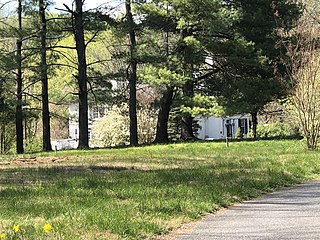
The Commodore Joshua Barney House is a historic home located at Savage, Howard County, Maryland, United States. It was originally situated on a 700-acre tract in modern Savage Maryland named Harry's Lot, at a time when the closest town was Elk Ridge. In 1809, Nathaniel F. Williams (1782-1864) married Caroline Barney, daughter of Joshua Barney, who in turn expanded an existing mill site on the property to create the Savage Mill.
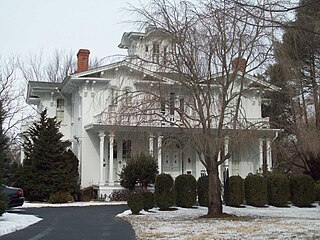
Temora, is a historic home located at Ellicott City, Howard County, Maryland. It is a T-shaped, two-story and cupola, Tuscan-style Victorian house of stuccoed tongue-and-groove boards. The house was built in 1857 after a design prepared by Nathan G. Starkweather, a little-known but accomplished architect from Oxford, England, who also designed the First Presbyterian Church and Manse at West Madison Street and Park Avenue in the Mount Vernon-Belvedere neighborhood in Baltimore, Maryland, with his later more famous assistant - Edmund G. Lind. The house was built for Dr. Arthur Pue Jr. on land given from his grandmother Mary Dorsey Pue of Belmont Estate.

Auburn House is a historic home located on the grounds of Towson University in Towson, Baltimore County, Maryland, United States. It was built in 1790 by Charles Ridgely III and stayed in the family until it became part of the Sheppard and Enoch Pratt Hospital property in 1944. Towson University acquired it in 1971.

The Eagle's Nest is a historic home located at Phoenix, Baltimore County, Maryland. It is a large fieldstone dwelling begun, it is believed, in the 1690s and completed in 1802 on part of a 2500-acre tract named "The Valley of Jehosaphat" by Richard Smith, Jr., who was granted the land by Lord Baltimore in 1684 in recognition of Smith's service as the first attorney general of Maryland. Smith's descendants owned the tract until Walter Dulany bought half of it in the 1720s and the other half about 20 years later.

Ravenshurst, or Ravenhurst, was a historic home located at Glen Arm, Baltimore County, Maryland, United States. It was a 2 1⁄2-story Carpenter Gothic-style board-and batten house built about 1854–1857. It was an addition to an earlier stone building thought to have been built about 1800. The home burned on October 31, 1985.
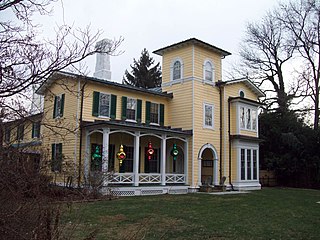
Villa Anneslie is a historic home located at Towson, Baltimore County, Maryland, United States. It was built about 1855 as a summer home. Designed by architect John Rudolph Niernsee, it is an Italianate two-story villa built in brick and covered in clapboard. It features an asymmetrical design with a central three story tower over the entrance.

The Lorraine Park Cemetery Gate Lodge is a historic gatehouse located near Woodlawn, Baltimore County, Maryland, United States. It is a 1 1⁄2-story, Queen Anne–style stone-and-frame building designed by Baltimore architect Henry F. Brauns that was constructed in 1884. Adjacent to the house are the ornate cast-iron and wrought-iron Lorraine Cemetery gates.

The Capt. John H. Ozmon Store is a historic general store located at Centreville, Queen Anne's County, Maryland. It is a two-story brick building constructed about 1880 into the side of a steep bank, with the store occupying the lower story and a dwelling on the second floor. Captain Ozmon was a prominent local merchant who built a considerable business transporting grain, lumber, and other merchandise by sailing schooner between Baltimore, Norfolk, and points on the Eastern Shore of the Chesapeake Bay.

Glen Arm is an unincorporated community in Baltimore County, Maryland, United States. Glen Arm lies along what is now Glen Arm Road, which was once part of Old Harford Road, one of the early routes used for conveying agricultural products from parts of Harford and Baltimore Counties and southern Pennsylvania to the port of Baltimore. Glen Arm was also served until 1958 by the Maryland and Pennsylvania Railroad. In 1921, at the railroad's crossing of Glen Arm Road, what generally is recognized as the nation's first train-actuated railroad crossing signal was installed by the railroad's Superintendent of Signals Charles Adler, Jr. Adler later designed early traffic-actuated traffic lights for the City of Baltimore, and also invented the system of flashing warning lights used on aircraft.

Young Men's and Young Women's Hebrew Association Building, also known as the Jewish Community Center, is a historic building located in central Baltimore, Maryland, United States. It is a three-story, flat-roofed, rectangular-shaped Flemish bond brick structure completed in 1930. The exterior features Moorish and Jewish motifs, such as the Star of David. It was designed by Baltimore architect Joseph Evans Sperry. It is now an apartment building. The establishment of the joining YM/YWHA building was a notable example of an attempt to bridge the divide between uptown Baltimore's prosperous German Jews and East Baltimore's impoverished Eastern European and Russian Jews. The association building was constructed midway between uptown and East Baltimore to symbolize this coming together of the two halves of Baltimore's Jewish community.
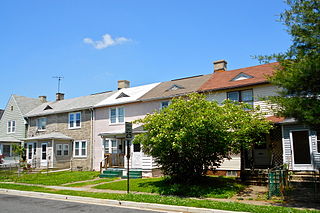
Dundalk Historic District is a national historic district in Baltimore, and Baltimore County, Maryland, United States. The district is a cohesive unit made up of residential, commercial, and institutional buildings with structures that generally date from 1910 to 1940. Major architectural styles represented include Period Revival and Art Deco/Streamline Moderne. The District includes 962 resources contribute to its significance. It includes the only two housing developments built by the United States Shipping Board Merchant Fleet Corporation (EFC) in Maryland during World War I and reflects experimentation with Garden City planning ideals. Many of the buildings within the District represent the work of noted Baltimore architect Edward L. Palmer, Jr.

Old Goucher College Buildings is a national historic district in Baltimore, Maryland, United States. It is an approximate 18-block area in the middle of Baltimore which developed in the late 19th and 20th centuries.

Stoneleigh Historic District is a national historic district at Towson, Baltimore County, Maryland, United States. It is a cohesive residential neighborhood in Central Baltimore County. The first 110-acre (0.45 km2) section of Stoneleigh was platted in 1922 and later enlarged in 1954 with the central 20 acres (81,000 m2) of land, on which the Italianate-style Stoneleigh Villa once stood. Domestic buildings in Stoneleigh extends from the 1920s to infill housing of the mid 1980s and are suburban examples of the Tudor Revival, Colonial Revival, French Revival, Spanish Mission Revival, Renaissance Revival, and Craftsman styles.
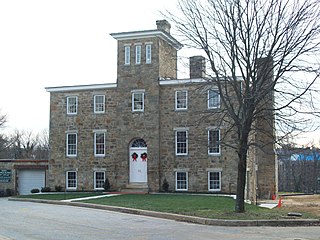
Baltimore County Jail is a historic jail located at Towson in Baltimore County, Maryland, United States. It was built in 1855 and is a two-story Italianate style stone building, measuring 52 feet wide and 62 feet deep. It consists of a five-bay-wide warden’s house with a central three story entry tower. In the rear is a cell block with three levels of jail cells and covered by a gable roof. The warden's house and tower features a low pyramidal hipped roof and 30-inch-thick (760 mm) walls. Attached to the warden's house is a stone garage built in 1940. It was used as a correctional facility until 2006.
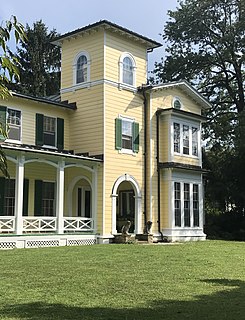
The Anneslie Historic District encompasses a residential area just north of the city line of Baltimore, Maryland in Towson. It is a grid of five streets extending eastward from York Avenue and south from Regester Avenue. The area was platted out in 1922 and mostly built out by the 1950s. Properties in the northern section of the district, on Regester Avenue, Murdock, Anneslie, and Dunkirk Roads, were built in the 1920s and 1930s, in Bungalow, Foursquare, and cottage styles, while the streets further south were built out primarily with Cape, Tudor, and Colonial style houses. The district takes its name from Anneslie estate, whose house still stands in the district.






















